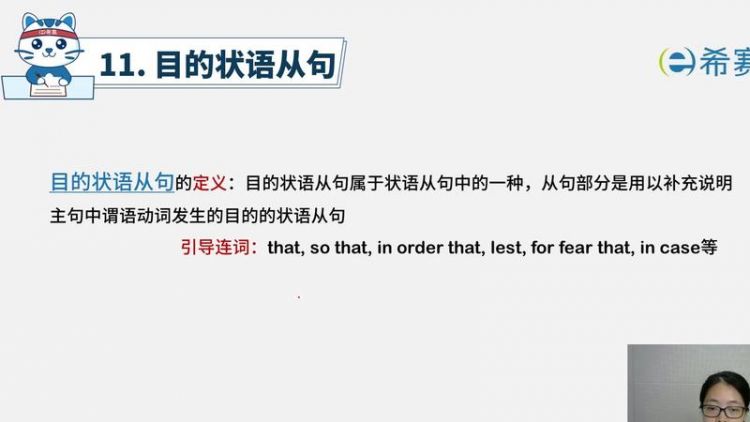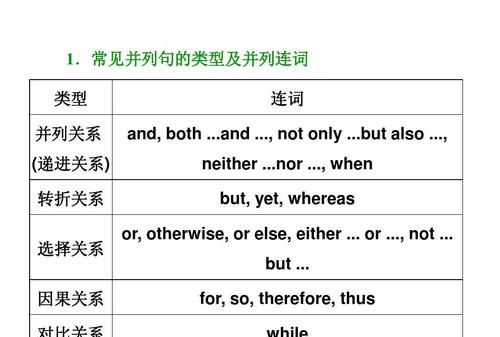本文目录
目的状语从句
目的状语从句由in order that,so that,lest,for fear that,in case等引导。其中so that即可引导结果状语从句又可引导目的状语从句。

英语中各类状语的英文名称是什么
.时间状语;(adverbial of time)
2.地点状语;(adverbial of place)
3.原因状语;(adverbial of cause)
4.条件状语;(adverbial of condition)
5.目的状语;(adverbial of purpose)
6.让步状语;(adverbial of concession)
7.比较状语;(adverbial of comparison)
8.方式状语;(adverbial of manner)
9.结果状语。(adverbial of result)

初中英语语法状语从句专练及答案
初中英语语法状语从句
对于英语中目的状语从句语法知识的讲解内容,希望同学们认真学习下面的知识。下面是我帮大家整理的初中英语语法状语从句,欢迎大家借鉴与参考,希望对大家有所帮助。

目的状语从句
通常由so that..., so...hat..., in order that... 等引导,往往放在句尾,从句中通常含有can / could / may / might等情态动词。
如:He got up earlier so that he could catch the first train. (他起身更早为的是赶上第一班车。)
以上对英语语法目的状语从句的讲解学习,相信同学们已经能很好的掌握了吧,努力学习哦!
初中英语语法大全:动词的种类
关于英语中动词的种类知识,希望同学们很好的掌握下面的内容学习。
动词的种类
动词是表示动作或状态的词,按其词义和在句子中的作用可分为行为动词,连系动词,助动词和情态动词。
1.行为动词
行为动词可分为及物动词 (vt)和不及物动词(vi),及物动词表示动作或状态,有完整的词义,能单独作谓语,后跟宾语;不及物动词表示动作或状态,有完整的词义,能单独作谓语,但后面不能直接跟宾语,如要带宾语则与介词或副词构成短语。
如:
More and more people study English.(vt)
The students are listening to the teacher carefully.(vi)
2.连系动词
连系动词本身有一定的词义,但不能独立作谓语,必须与表语一起构成谓语。常用的连系动词有 be, get, turn, become, look, feel, grow, seem, sound, taste, smell等。
如:
Our country is becoming stronger and stronger.
It feels damp.
3.助动词
助动词本身无词义,不能单独作谓语,只能和主要动词一起构成谓语动词,表示否定,疑问及动词的时态、语态、人称和数等语法特征,助动词有 be,do,have,shall,will等。
如:
How do you usually come to school?
The children are playing yo-yo now.
4.情态动词
情态动词本身有一定的意义,但不能独立作谓语,只能和主要动词原形一起构成谓语,表示说话人的语气和情态。情态动词没有人称和数的变化。情态动词有 can (could),may(might),must, need, ought to, dare等。
如:
Can I help you?
- Must we go now? -No, you needn't .
a. can与be able to的用法有所区别。can只用于一般现在时和过去时,指本身有能力的"能";be able to用于各种时态均可,指须经过努力而"能"。
b. must与have/has to的用法。must表示说话人主观认为"必须",只用于一般现在时和一般将来时;have/has to表示客观需要,意为"不得不",它可用于各种时态。
c.need和dare既可作情态动词也可作行为动词。
以上对动词的种类知识的内容讲解学习,相信同学们已经能很好的掌握了吧,希望同学们在考试中取得很好的成绩。
初中英语语法大全:动词不定式的形式
对于英语的学习中,关于动词不定式的形式知识点的内容,我们做下面的'讲解学习哦。
动词不定式的形式
1.作主语。 如:
To learn English is very important.
但实际上不定式作主语常用 it来作形式主语,而将不定式移至谓语动词后作真正的主语。
如上句可表达为:
It's very important to learn English.
2.作表语。 如:
My idea is to ring him up at once.
3.作宾语。 如:
I have decided to go to Binjiang Primary School.
4.作宾语补足语。
a. ask, want, teach, tell, know, would like, allow等动词后面接动词不定式作宾语补足语。
如: The policemen asked him to get off the bus.
b. hear, see, look at, feel, watch, notice, listen to等动词后接不带to的动词不定式作宾语补足语。
如: We often see Miss Li clean the classroom.
c. let, make, have这些使役动词后接不带to的动词不定式作宾语补足语。但在被动语态中这些不带to的都须带上to。
如: In those days the bosses often made the workers work day and night.
d.动词help接动词不定式作宾语补足语,可带to也可不带to。
如: Can you help me (to) carry the heavy bag?
5.作定语。
a.与被修饰词有动宾关系。如:I have something important to tell you.但如果不定式动词为不及物动词,后面的介词千万不要省略。
如: Maybe they have three rooms to live in.
b.与被修饰词有主谓关系。
如: Mr Liang is always the first to come and the last to leave.
c.与被修饰之间只有修饰关系。
如: I have no time to play cards.
6.作状语,表示目的、原因、方法、方向、结果等。
如: I'll go to meet my friend at the railway station.
7.不定式复合结构"for sb. to do sth" 作主语时,常用"It is +adj+ for
of sb. to do sth"的句式。形容词good, bad, polite, unkind, kind, ice, clever,
right, wrong, careful等用"It is +adj +of sb. to do sth."
其他形容词用 for。
如:
It's dangerous for you to ride so fast.
It's very kind of you to help me.
8.动词不定式与疑问句who, what, which, when, how, where, whether等连用。
如: I don't know when to start.
He didn't tell me where to go.
但上面结构相当于一个从句,故上述句子也可表达为:
I don't know when we'll start.
He didn't tell me where he would go.
注意:
a.有些动词或动词短语不能带不定式,只能接动词的-ing形式。
如: enjoy, finish, keep, mind, miss(错过),be busy, go on, keep on, be worth, practise等。
如: The peasants are busy picking apples.
Would you mind my opening the door?
b.有些动词后可接不定式,也可接动词的-ing形式,但意思不同。
如: Lu Jian forgot to post the letter.(该寄但还没做)
Lu Jian forgot posting the letter.(已经寄过信了)
They stopped to sing a song.(停止在做的工作而去做另一件工作)
They stopped singing.(停止正在做的工作)
希望上面对动词不定式的形式知识的内容讲解学习,同学们都能很好的掌握,相信同学们会取得很好的成绩的哦。
初中英语语法大全:短语动词的四种类型
同学们认真学习,下面是老师对短语动词的四种类型知识总结。
短语动词的四种类型
动词与介词、副词等构成的固定短语,叫短语动词。主要有四类:
一、动词+副词
有的一般不跟宾语,如go ahead, fall behind, get up, lie down, go up, run out, give in, stay up等;有的可以跟宾语,如put out, carry out, give up, wake up, check in, eat up, fill in, find out, fix up, hand in, mix up, look up, make out, turn down, work out等。
注意:宾语是名词时,放在副词前面或后面都可以,但若作宾语的是人称代词时,就只能放在动词和副词之间了。如:
We’ve decided to put the meeting off (=put off the meeting) . 我们决定把会议推迟。
We’ve decided to put it off. 我们决定将它推迟。(不说put off it)
二、动词+介词
如ask for, care for, call for, break into, deal with, call on, look for等。后面必须接宾语。如:
I don’t care for tea. 我不喜欢喝茶。
三、动词+副词+介词
如look forward to, put up with, looked up to, go in for, go along with, date back to, look down on, keep up with, add up to, run out of等。如:
She soon caught up with us. 她很快赶上了我们。
四、动词+名词+介词
如take care of, pay attention to, make use of, make contribution to做出贡献等。如:
Take care of your brother while I am away. 我不在的时候,你要照顾好你弟弟。
希望上面老师对短语动词的四种类型知识的讲解学习,同学们都能很好的掌握,相信同学们会学习的很好的哦。
初中英语语法大全:及物动词与不及物动词
关于英语中及物动词与不及物动词的知识学习,我们做下面的内容讲解。
及物动词与不及物动词
根据其后是否带宾语,动词可分为及物动词(带宾语)和不及物动词(不带宾语)。如:
When will he arrive? 他什么时候到?(arrive 不带宾语,为不及物动词)
He reached Beijing yesterday. 他昨天到达北京。(reach 带了宾语,为及物动词)
有的动词既可用作及物动词也可用作不及物动词:
The child is playing. 这小孩在玩。(不及物用法)
The child is playing the piano. 这小孩在弹钢琴。(及物用法)
He is writing. 他在写字。(不及物用法)
He is writing a letter. 他在写信。(及物用法)
The boy is reading. 这男孩在阅读。 (不及物用法)
The boy is reading a magazine. 这男孩在看杂志。(及物用法)
上面对及物动词与不及物动词知识的内容讲解学习,希望给同学们的学习很好的帮助,相信同学们会学习的更好的吧。
初中英语语法大全:实义动词与非实义动词
下面是对英语中实义动词与非实义动词知识的内容讲解,希望同学们很好的掌握。
实义动词与非实义动词
根据其含义和句子功用,动词可分为实义动词和非实义动词(包括时态助动词和情态助动词等)。如:
He bought a story book. 他买了一本故事书。(buy 为实义动词)
He has read the story book. 他已读过这本故事书。(has 为时态助动词,read为实意动词)
He should read the story book. 他应该读读这本故事书。(should 为情态助动词,red为实义动词)
上面对实义动词与非实义动词知识的内容讲解学习,相信同学们已经能很好的掌握了吧,希望同学们考试成功。
知识延伸:
1.if, when引导从句时态注意点:
(1)when,if引导宾语从句:主句一般现在时,从句可使用任何时态;主句使用过去时,从句也要使用过去的某种时态;
(2)When,if引导时间状语从句:遵循主将从现原则(主句将来时,从句一般现在时,即从句不可出现when/if + 主语 + will/be going to do的形式)
2.到达的三种表达方法:
arrive at/in someplace = get to someplace = reach someplace
3.let`s , let us用法
(1)Let`s do sth: 让我们做某事吧(说者和听者共同来做),
表示建议,反义疑问shall we?
(2)Let us do sth:让我们做某事吧(只有说者做)
表示征询建议,反义疑问句will you?
4.go fishing:钓鱼;
5.nobody:是不定代词,不定代词做主语时,谓语动词使用单数形式。常见不定代词:
anybody,anyone,anything,someone,somebody,something,everyone,everybody,
拓展延续
英语语法(复合句)讲解:状语从句
一、状语从句的定义及分类
状语从句在复合句中修饰主句或者主句中的动词。状语从句由从属连词引导,与主句连接,位于句首时,常用逗号与主句分开,位于句末时,前面一般不用逗号。状语从句根据其用途可以分为:时间状语从句、原因状语从句、结果状语从句、条件状语从句、让步状语从句、地点状语从句、目的状语从句等。
二、时间状语从句
1.when的用法
① when意为“当……时候”,引导时间状语从句,表示主句的动作和从句的动作同时或者先后发生。
I feel very happy when you come to see me.
When you are crossing the street, you must be careful.
② when引导的时间状语从句中的动词可以用延续性动词或者非延续性动词。
I worked for a foreign company when I was in Shanghai.
2.while的用法
while引导的时间状语从句,常常翻译为“与……同时、在……期间”,while引导的从句常用延续性动词或表示状态的动词。
They rushed in while we were discussing problems.
My mother was cooking while I was doing my homework.
3.as的用法
as引导时间状语从句时可以表示“正当、一边……一边……、随着”等意思。
Helen heard the story as she washed clothes.
We get wiser as we get older.
4.before/after的用法
before表示“在……之前”,after表示“在……之后”。
I will always work hard before I enter Peking University.
She showed me many beautiful stamps after I got to her home.
5.until/till的用法
until和till都表示“直到”,常可互换,但till不用于句首。
① 主句谓语动词是延续性动词时,主句用肯定形式,表示这一动作或者状态一直持续到until/till引导的从句的动作发生为止。
I'll wait for you until you come to see me.
② 主句的谓语动词是非延续性动词时,主句用否定形式,表示主句的动作直到until引导的从句的动作发生才发生,构成not...until结构,表示“直到……才……”。
I didn't go to bed until I finished my homework.
6.since的用法
since引导的时间状语从句,表示“自……以来”,主句用现在完成时,从句用一般过去时。
I have worked in this company since I graduated from Peking University.
7.as soon as的用法
as soon as引导的时间状语从句,表示从句的动作一发生,主句的动作随即发生,意为“一……就……”。该从句经常用一般现在时表示将来。
As soon as he arrives, I'll tell him.
三、条件状语从句
主句为祈使句、一般将来时或含有情态动词时,条件状语从句用一般现在时。
1.if的用法
if引导条件状语从句,表示“如果、假如”。
I'll visit the Great Wall if it doesn't rain tomorrow.
2.unless的用法
unless引导条件状语,表示“除非、如果不”,相当于if not。
We'll go for an outing tomorrow unless it rains.
四、原因状语从句
原因状语从句通常用because, since或as引导,这三个词所表示的语气由because到as逐渐减弱。
1.because的用法
because表示因果关系时,语气最强,用来回答why的提问,所表示的原因往往是听话人所不知道或者感兴趣的。
I'm leaving because I am fed up with the boss.
My friends admire me because I am handsome and successful.
2.since的用法
表示人们已知的事实,不需要强调的原因,因此常常翻译为“既然……”,通常放在句首。
Since Monday is Bob's birthday, let's give him a party.
Since everyone is here, let's get started.
3.as的用法
as与since差不多,所引出的理由在说话人看来已经很明显,或已为说话人所熟悉。
She didn’t hear us come in as she was asleep.
五、目的状语从句
目的状语从句通常由so that,in order that等引导,谓语中常含有may, might, can, could, will, would等情态动词。
He must get up early so that he can go to work on time.
六、结果状语从句
1.由so...that, such...that引导
so...that与such...that引导结果状语从句时,在结构上有所不同:
so+形容词/副词+that
such+a/an+形容词+单数名词+that
such+形容词+复数名词+that
such+形容词+不可数名词+that
so+形容词+a/an+单数名词+that
注意:当名词前面有many, much, little, few修饰时,用so而不用such。
She is such a lovely girl that we love her very much.
=She is so lovely a girl that we lover her very much.
We have so much time that we can finish the work very well.
2.结果状语从句与不定式结构的相互转换
so...that句型的否定形式可与too...to...或者not...enough to相互转换。
He is so young that he can't go to school.
=He is too young to go to school.
=He is not old enough to go to school.
七、让步状语从句
1.though/although的用法
although和though意义一样,意为“虽然、尽管”,都表示让步,一般情况下可以互换,两者可以与yet连用,但是不与but连用。
They are generous though they are poor.
Although he was a Japanese, he spent most of his life in China.
2.even though/even if的用法
even though和even if都是“尽管、即使”的意思,表示语气更强的让步。
Even though he's 24 now, he's still like a little child.
We'll make a trip even if/even though the weather is bad.
八、地点状语从句
引导地点状语从句的从属连词主要是where和wherever。
He lives where the climate is cool.
Where there is a will, there is a way.
;英语中目的状语是什么意思
英语中的目的状语有哪些?
目的状语具有一定的目的表达性,以下是我整理的英语中的目的状语有哪些?欢迎参考阅读!

一、用to do sth表目的
用不定式表目的是最简单也是最常用的方法,它既可以用于句末,也可用于句首,但比较而言,用于句首时,其强调意味较浓。如:
After missing a term through illness he had to work hard to catch up with the others. 他因病一学期未上课,得努力赶上其他同学。
To avoid any delay please phone your order direct. 为免延误,请直接打电话预订。
To keep themselves awake they sat on the floor and told each other stories. 为了不至于睡着,他们坐在地板上轮流着讲故事。
To avoid back problems, always bend your knees when you lift heavy objects. 为了不使背部受伤,你在扛重东西时,一定要将膝盖弯曲着。
不定式的否定式为not to do sth,而不是 to not do sth。如:
She had to struggle not to give in to a desire to laugh. 她极力控制自己不要笑出来。
Then there was the mad rush not to be late for school. 然后就是匆忙往学校赶,以免迟到。
I went to France not to study French, but to study architecture. 我去法国不是为了学法语,而是为了学建筑。
He claimed he had bought the cigarettes for home consumption, not to sell them. 他声称他买烟是为了自家享用,不是为了出售。
二、用so as to do sth表目的
so as to do sth是to do sth的变体,意思是“以便”“为了”“为的是”等。用so as to do sth表示目的时,它通常用于句末。如:
I left a message so as to be sure of contacting her. 我留下了张条子以便与她取得联系
The two lovers dropped back so as to be alone. 那对情人落在后面,为的是两人好单独在一起。
I always keep fruit in the fridge so as to keep insects off it. 我总是把水果放在冰箱里,以防虫子叮咬。
表示目的的so as to do sth有时也可放在句首(但是若so as to do sth是表示结果,则不可放在句首)。如:
So as to show his boss what a careful worker he was, he took extra trouble over the figures. 为了向老板显示他是个工作非常细心的人,他在这些数字上费了比平常更多的力气。
so as to do sth的否定式是so as not to do sth,意思是“为了不……”“以免”。如:
They tiptoed upstairs so as not to wake the baby. 他们踮着脚上楼,以免吵醒孩子。
We left in the daytime so as not to arouse suspicion. 我们在白天离开以免引起怀疑。
I shut the door quietly, so as not to wake the baby. 为了不惊醒宝宝,我轻轻地关上门。
三、用in order to do sth表目的
in order to do sth也是to do sth的变体。用in order to do sth表示目的时,它既可以用于句末,也可用于句首,但比较而言,用于句首时,其强调意味较浓。如:
She lied about her age in order to get the job. 她为了谋得那份工作隐瞒了年龄。
She arrived early in order to get a good seat. 她到得很早,图的是得个好座位。
Teamwork is required in order to achieve these aims. 完成这些目标需要团队合作。
In order to get the job you must be able to drive. 要做这项工作你得会开车。
In order to get into a good school, I must study even harder. 为了考入一个好的学校,我必须更加用功。
in order to do sth的否定式是in order not to do sth,意思是“为了不……”“以免”。如:
She slept in a separate room in order not to disturb him. 她在另一房间睡觉,为了不至打扰他。
Please reply at once in order not to lose this opportunity of a lower price. 请立即回复,以免失去这次低价的机会。
They must have worn gloves in order not to leave any fingerprints. 他们一定戴上了手套,以防留下指纹。
注意,in order to do sth 还有另外一个否定形式,那就是 not in order to do sth,其意为“不是为了……”。如:
Big farmers are moving in, not in order to farm, but in order to speculate with rising land prices. 大农场主正在不断涌进来,不是为了耕作,而是要利用不断上涨的地价进行投机。
This expression refers to encounters between ships of hostile nations. One ship might fire a shot at another, not in order to hit it, but to warn it to move. 这个表达源于敌对国船只在海上相遇时,一方可能向另一方鸣炮,不是为了击中目标,而是警告其快速离开。
四、用so that表目的
so as to和so that均可表示目的,两者的区别是,前者引出不定式,后者用以引导目的状语从句。与用so as to do sth表示目的的情形相似,so that引导的目的状语从句通常位于主句之后。如:
I will give him a key so that he can get into the house whenever he likes. 我会给他一把钥匙,好让他能随时进来。
I got here early so that we could have a few minutes alone together. 我到这儿早些是为了我们能单独在一起待几分钟。
They wrote the notices in several languages so that foreign tourists could understand them. 他们把通知用几国文字写出来,以便让各国游客都能看得懂。
有时可省略其中的that。如:
Leave the keys out so (that) I remember to take them with me. 把钥匙放在外面,好让我记得带。
I deliberately didn’t have lunch so (that) I would be hungry tonight. 我有意没吃午饭,为的就是让自己今晚能感到饿。
so that 引导的目的状语从句有时还可置于主句之前(但是,若so that引导的从句是表示结果,则不可放在句首)。如:
So that I shouldn’t worry, he phoned me on arrival. 为了不让我担心,他一到就给我打了电话。
So that I shouldn’t forget it, I made a knot in my handkerchief. 为了免得忘记,我将手帕打了一个结。
So that the coming generation can learn the martial arts, he has recently devoted much time to writing books on the subject. 为了下一代能够学会这些武术,他近来花了许多时间著书立说。
五、用in order that表目的'
in order to和in order that均可表示目的,两者的区别是,前者引出不定式,后者用以引导目的状语从句。与用in order to do sth表示目的的情形相似,in order that引导的目的状语从句可以位于主句之前或之后。如:
We arrived early in order that we could get good seats. 我们到得早,以便找到好座位。
These men risk their lives in order that we may live more safely. 这些人甘冒生命危险,为的是让我们生活更安全。
I bought a new car in order that my wife might learn to drive. 我买了一辆新车,以便我妻子学习驾驶。
In order that you may create such a picture, you have to possess certain artistic weapons. 创作这样的画,你得具有某些艺术手段。
六、用in case表目的
in case用于引导目的状语从句时,意思是“以防”“以免”。如:
He took his umbrella in case it should rain. 他带上了雨伞,以防下雨。
You’d better take the keys in case I’m out. 你最好带上钥匙,以防我不在家。
Listen out for the baby in case she wakes up. 注意听宝宝的动静,她醒来好知道。
in case 引导的目的状语从句有时也可位于主句之前。如:
In case anyone was following me, I made an elaborate detour. 为了防止有人跟踪我,我特地绕了弯路。
注:也有人认为这样用的in case 从句为原因状语从句,意思是“因为怕……”。比较:
I had a snack, just in case there was no time to eat later. 我吃了些点心,以防过会儿没有时间吃饭。(将in case译成“以防”,将之视为目的状语从句)
I had a snack, just in case there was no time to eat later. 我吃了些点心,因为怕过会儿没有时间吃饭。(将in case译成“因为怕”,将之视为原因状语从句)
Here's a contact number, in case there should be a problem. 这是联系电话,以防有问题出现。(将in case译成“以防”,将之视为目的状语从句)
Here's a contact number, in case there should be a problem. 这是联系电话,因为怕有问题出现。(将in case译成“因为怕”,将之视为原因状语从句)
七、用for fear (that) 表目的
for fear that 用于引导目的状语从句时,与 in case 大致同义,意思是“以防”“以免”。如:
He’s working hard for fear (that) he should fail. 他在努力工作唯恐他会失败。
She finally ran away for fear that he would kill her. 她最后逃走了,因为怕被他杀了。
Scientists reject a total ban for fear it will undermine efforts to stop the spread of malaria. 科学家们反对全面禁止,以免削弱为防止疟疾扩散所作的努力。
注:与in case一样,for fear that 引导的从句有时也被理解为原因状语从句,并将其翻译为“因为怕……”。比较:
Shut the window for fear that it may rain. 把窗子关上以防下雨。(将for fear that 译成“以防”,将之视为目的状语从句)
Shut the window for fear that it may rain. 把窗子关上,因为怕下雨。(将for fear that 译成“因为怕”,将之视为原因状语从句)
;以上就是关于目的状语从句英文怎么说,目的状语从句的全部内容,以及目的状语从句英文怎么说 的相关内容,希望能够帮到您。
